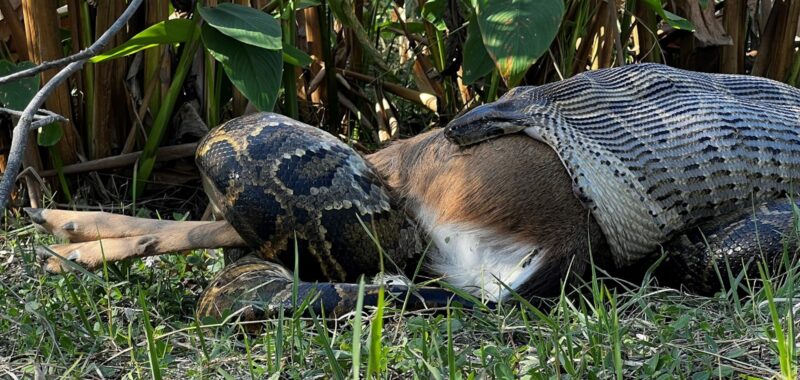Invasive Burmese pythons are without question the bane of Florida’s ecosystems. Since their confirmed presence in the Everglades National Park in 2000, their destructive impact on native wildlife has spread throughout the state as populations continue to explode. It’s so bad that some scientists are urging people to consider adopting a diet that’s heavier on python meat, while Florida now officially hosts an annual Python Hunting Challenge to help cull the reptile’s numbers. But as experts continue their uphill battle against the serpents, it’s becoming clearer how Burmese pythons are so well-equipped to thrive in the Panhandle State—new research proves the snakes are capable of swallowing prey that are even bigger than mathematical models suggested possible.
Burmese pythons are born from nests containing between 50-100 eggs, and initially measure around two-feet-long. By the end of their first year, however, they routinely double in size. Most adults don’t exceed 16 ft in length, but hunters have documented a handful spanning almost 20 ft and weighing over 200 lbs each. Their diets involve swallowing whole bobcats, raccoons, foxes, and even alligators—this is made possible thanks to their lower jawbone that isn’t fused at the front, which allows them to stretch them basically as far as their soft, pliable skin can handle. This makes a Burmese python capable of consuming prey six-times-bigger than what other snake species of similar sizes can eat. But according to a study recently published in the journal Reptiles & Amphibians, these gaping maws can expand bigger than experts once believed.

“Watching an invasive apex predator swallow a full-sized deer in front of you is something that you will never forget,” Ian Bartoszek, a researcher at the Conservancy of Southwest Florida and study co-author, said in a statement on October 24th.
Working alongside Bruce Jayne, a University of Cincinnati professor of biological sciences and study co-author, as well as Conservancy of Southwest Florida coworker Ian Easterling, Bartoszek and colleagues recently got hands on to measure a trio of captured snakes measuring 15-, 17-, and 19-feet-long. Although previously examined pythons have been documented with mouth gape diameters as wide as 8.7 in, the largest of the study’s pythons could extend their gape to 10.2-in-wide.
“That doesn’t sound like a lot—just 18-percent bigger,” Jayne said on Thursday.
But this means a snake’s overall mouth size expands in conjunction with the larger diameter, says researchers, who add this means a 10.2-in gape increases its total area by 40-percent. In the largest pythons, this translated to a circumference equal to a pair of 32-inch-waist jeans. Given that the team documented one snake devouring a 77-lbs deer about two-thirds its total mass, these potential prey revisions both revise existing impact estimates, as well as help explain how Burmese pythons are inflicting so much ecological damage in Florida.
[Related: Scientists propose eating more python.]
“The impact the Burmese python is having on native wildlife cannot be denied. This is a wildlife issue of our time for the Greater Everglades ecosystem,” stressed Bartoszek.
Jayne and their team also realized additional implications after studying and extrapolating the scalability ratio between their mouth gapes and cranial structures.
“It’s almost a certainty that we have yet to capture the biggest Burmese python in Florida,” said Jayne. “So, it seems very plausible that a record-breaking python with a gape of (11.8 in) could eat a 120-pound deer.”

According to Thursday’s announcement, Bartoszek’s team have so far removed 770 pythons that measure over 6.5 ft-long. Researchers said that if each snake ate a single baby deer—which they are perfectly capable of doing—then that would add up to about 13,000 pounds of prey removed from their natural ecosystem. And that’s just a single meal.
Since Burmese python populations are still expanding across Florida, Jayne warns this could just be the “tip of the iceberg.” Without effective mitigation plans, the team warns there is a chance the snakes—with even larger mouths than thought—could eventually slither into wider portions of the Southeastern US.

